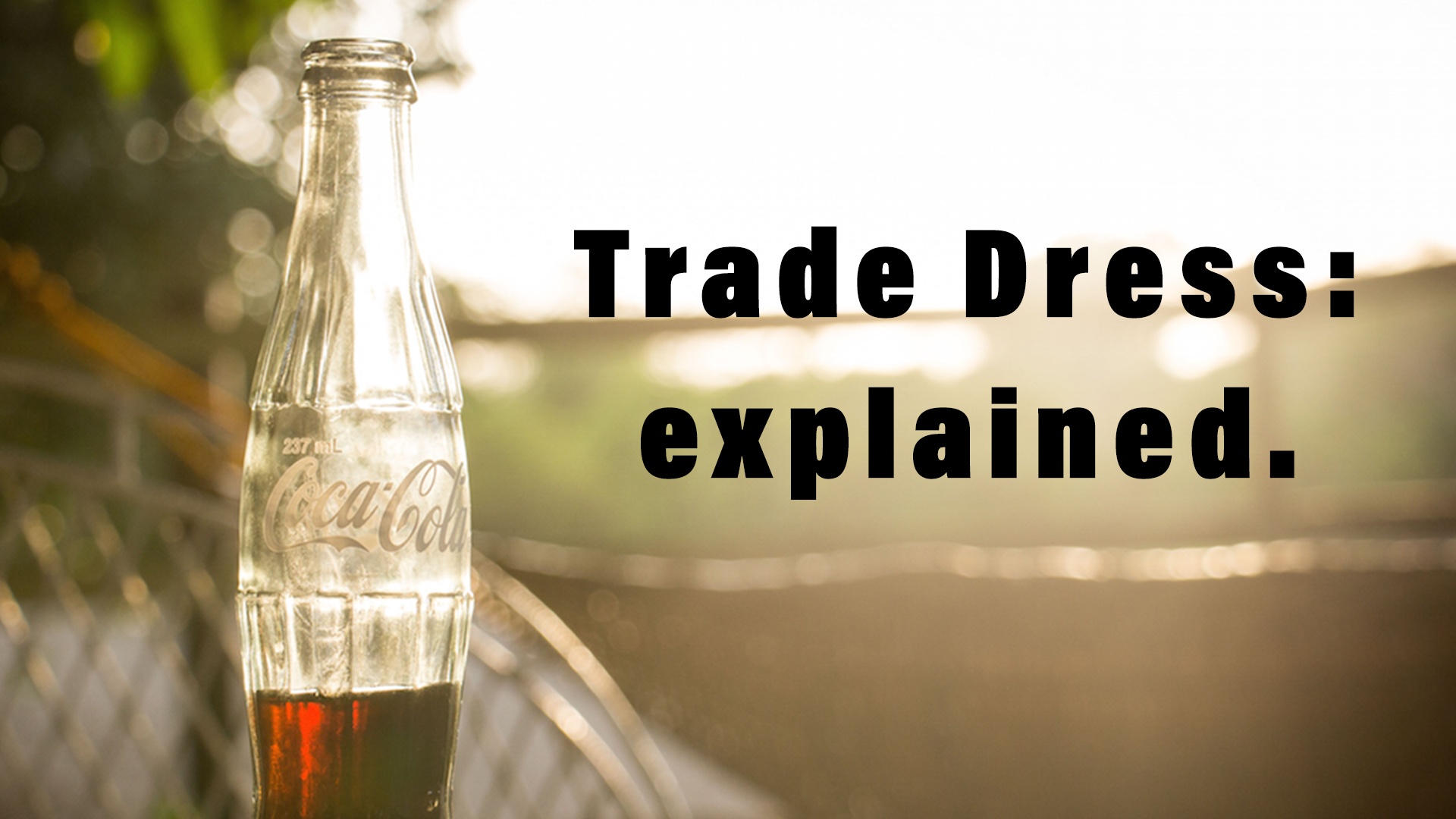
What Is Trade Dress?
Trade Dress is defined as:
“the total appearance and image of a product, including features such as size, texture, shape, color or color combinations, graphics, and even particular advertising and marketing techniques used to promote its sale.” [1]
Perhaps the most iconic trade dress is the Coca-Cola bottle. The shape and color of this bottle is completely recognizable around the globe. This bottle has become so intertwined with Coca-Cola, no one else can use that shape and color bottle for its beverages or for many other products.
Unlike a trademark, trade dress does not need to be registered.
 This means that if the product’s packaging has such a unique and representative size, shape, and/or color, then it can be protected under trade dress. Additionally, trade dress rights are not term limited. Trade dress never expires. Your rights can virtually last forever as long as your trade dress serves to identify your product or service as coming from a lone source.
This means that if the product’s packaging has such a unique and representative size, shape, and/or color, then it can be protected under trade dress. Additionally, trade dress rights are not term limited. Trade dress never expires. Your rights can virtually last forever as long as your trade dress serves to identify your product or service as coming from a lone source.
The United States Supreme Court decision in a case called “Two Pesos” supports the idea that trade dress and trademarks should be given the same weight in a legal dispute. The Court held that a trade dress may be protected if it is “inherently distinctive.” [2]
In another case involving Walmart, the court ruled that trade dress not only included packaging, but also included the product design. [3]
In another case, the US Supreme Court could not find any “theoretical objection to the use of color alone as a trademark, where that color has attained ‘secondary meaning.’” [4] For example, when someone mentions Tide detergent, the first thing that comes to mind is that bright orange color used on all Tide’s products. This specific color is universally recognized and accepted as Tide Detergent orange.
There is a “four-part test” that governs whether or not a product’s trade dress is inherently distinct:
- Does the product use a “common” basic shape or design;
- Whether it was [not] unique or unusual in the particular field;
- Whether it was a mere refinement of a commonly-adopted and well-known form of ornamentation for a particular class of goods viewed by the public as a dress or ornamentation for the goods; or
- Whether it was capable of creating a commercial impression distinct from the accompanying words. [5]
In the case of Coca-Cola, the bottle was not a common shape or design, it was unique. There was no other bottle shape in the soda industry like this bottle and it made everyone think of Coca-Cola when they saw it. Your ideal trade dress for your brand will want to do the exact same thing. You want people to automatically think of your product when they see a certain shape or color.
Secondary Meaning
When your product cannot be shown to be inherently distinct, it can still be protected if you prove that it has “secondary meaning.”
Secondary meaning is defined as:
“the power of a name or other configuration to symbolize a particular business, product or company.” [6]
When someone mentions detergent or sees that bright orange color, the first thing that comes to mind is Tide. Tide has a dress on that color as well as having become a huge name in detergent. When someone sees the iconic orange color, they think of Tide Detergent.
Your trade dress can also acquire secondary meaning when consumers relate the trade dress with a specific producer instead of a product…[7] the Coca-Cola bottle.
For your brand to have trade dress protection, you need to make sure that your products are a direct symbol your brand. You need to make sure that when a consumer sees your products, they think of your brand.
Functionality
To help ensure that your product cannot be emulated in a way that would be harmful to you, the product cannot be functional. The Court noted Inwood Laboratories, Inc. v. Ives Laboratories, Inc., “a product feature is functional if it is essential to the use or purpose of the article or if it affects the cost or quality of the article.” [8]
The functionality defense is one of the most viable and used defenses in a trade dress case.
The test of functionality is not whether the individual elements of the product are functional, but whether the overall combination is functional. [9] The orange color of the Tide detergent is not functional. This color is not essential to the purpose of the detergent bottle. The color simply identifies Tide products. Your trade dress can be what causes the consumer to think of your brand, but it cannot be something that is essential to the function of your product.
There are two basic types of functionality to keep in mind: utilitarian & aesthetic.
The utilitarian functionality is determined using 4 factors:
1) does feature deliver any utilitarian advantage
2) are there alternative designs
3) does advertising tout the utilitarian advantages of the design
4) whether the particular design results from a comparatively simple or inexpensive method of manufacture. [10]
If any of the above factors are satisfied, the trade dress is not protectable. In terms of the Coca-Cola bottle, the shape of the bottle is not functional. There is no advantage and there are several other bottle designs. There is nothing about the shape of the bottle that gives it an advantage over competitors as far as the bottle’s ability to hold liquid, in any way.
Aesthetic functionality is defined as “when goods are bought largely for their aesthetic value, their features may be functional because they definitely contribute to that value, and thus aid the performance of the object for which the goods are intended.” [11] In a business sense, the Supreme Court employs another test known as the “competitive” test.
This test states “a functional feature is one the ‘exclusive use of [which] would put competitors at a significant nonrepudiation-related disadvantage.” [12] Similarly to utilitarian functionality, the Coca-Cola bottle cannot be labeled as aesthetically functional. The shape of the bottle does not make the consumer buy more than other competitors. The shape merely identifies the product as a Coca-Cola product.
When designing products, make sure that individual aspects of your product when put together, are not functional. They can be identifiable as your brand, but it cannot give your product any advantage over competitors. Aspects such as shape and color can serve to identify your brand, but your product cannot be protected if it is found that certain aspects are functional according to the stated above standards.
Protection and Remedies for Trade Dress Violations
There are many forms of statutory trade dress protection.
The primary means for the protection of trade dress under federal law is Section 43(a)(1) of the Lanham Act, 15 U.S.C.A. § 1125(a)(1), which encompasses unregistered marks. This section states that anyone who sells goods so similar to yours that it causes confusion or misrepresents your goods is liable in a civil action.
While there is no requirement to register trade dress, if you choose to register, you can bring your claims under 15 U.S.C.A. § 1114, as well as the Lanham Act Section 43(a) claim for trade dress infringement.
If someone has infringed upon your trade dress rights, the primary form of remedy available to you is injunctive relief. Injunctive relief is where a court orders a party to act or refrain from acting in a certain way.
“A plaintiff whose trade dress has been infringed is entitled to an injunction pursuant to 15 U.S.C. § 1116 to prohibit the infringer from further misappropriating and exploiting that trade dress.” [13]
You may also be awarded damages.
Showing that the offending party significantly decreased the number of products that you sold, lost profits may be recoverable in addition to other types of damages.
Other remedies include the destruction or the recall of the infringing products. Recalls ordered in trade dress cases are based on several factors, including intentional copying. [14] For example, if someone copied the shape of the Coca-Cola bottle in order to piggy-back on their success, Coca-Cola may seek relief from a court, specifically to recall the infringing bottles and have them destroyed. However, a recall can be denied in cases where the burden to the defendant or offending party would be too great. This being the case, you must always be careful not to overreach in asking for remedies as overstepping the bounds of reason may open you up to a counterclaim.
[1] John H. Harland Co. v. Clarke Checks, Inc., 711 F.2d 966, 980 (11th Cir. 1983).
[2] Two Pesos, Inc. v. Taco Cabana, Inc., 505 U.S. 763, 770 (1992).
[3] Wal-Mart Stores v. Samara Bros., 529 U.S. 205 (2000).
[4] Qualitex Co. v. Jacobson Prods. Co., 514 U.S. 159 (1995).
[5] Frankish Enterprises Ltd., 113 U.S.P.Q.2d 1964, 2015 WL 1227728 (T.T.A.B. 2015) (citing Chippendales USA, Inc., 622 F.3d 1346, 96 (Fed. Cir. 2010) (quoting Seabrook Foods, Inc. v. Bar-Well Foods, Ltd., 568 F.2d 1342 (C.C.P.A. 1977)).
[6] Dall. Cowboys Cheerleaders, Inc. v. Pussycat Cinema, Ltd., 604 F.2d 200 (2d Cir. 1979) (“[P]laintiff’s uniform is universally recognized as the symbol of the Dallas Cowboys Cheerleaders”) (quoting, Ideal Toy Corp. v. Kenner Prods. Div. of Gen. Mills Fun Grp, Inc., 443 F. Supp. 291 (S.D.N.Y. 1977)).
[7] M. Kramer Mfg. Co. v. Andrews, 783 F.2d 421 (4th Cir. 1986).
[8] Inwood Labs. v. Ives Labs., 456 U.S. 844, 850 (1982) (citing Sears, Roebuck & Co. v. Stiffel Co., 376 U.S. 225, 238 (1964)).
[9] Sunbeam Prods. v. W. Bend Co., 123 F.3d 246 (5th Cir. 1997) (“Insofar as the trade dress of a product entails its ‘total image’ and ‘overall appearance,’ an arbitrary combination of functional features may nevertheless be nonfunctional for purposes of trade dress protection.”) (citation omitted).
[10] Disc Golf Ass’n v. Champion Discs, Inc., 158 F.3d 1002, 1006-09 (9th Cir. 1998).
[11] Moore Business Forms, Inc. v. National Computer Systems, Inc., 211 USPQ 909 (TTAB 1981).
[12] Traffix Devices v. Mktg. Displays, 121 S. Ct. 1255 (2001).
[13] Bayline Partners L.P. v. Weyerhaeuser Co., 31 (N.D. Cal. 1994).
[14] Perfect Fit Indus., Inc. v. Acme Quilting Co., 646 F.2d 800, 804, (2d Cir. 1981).


